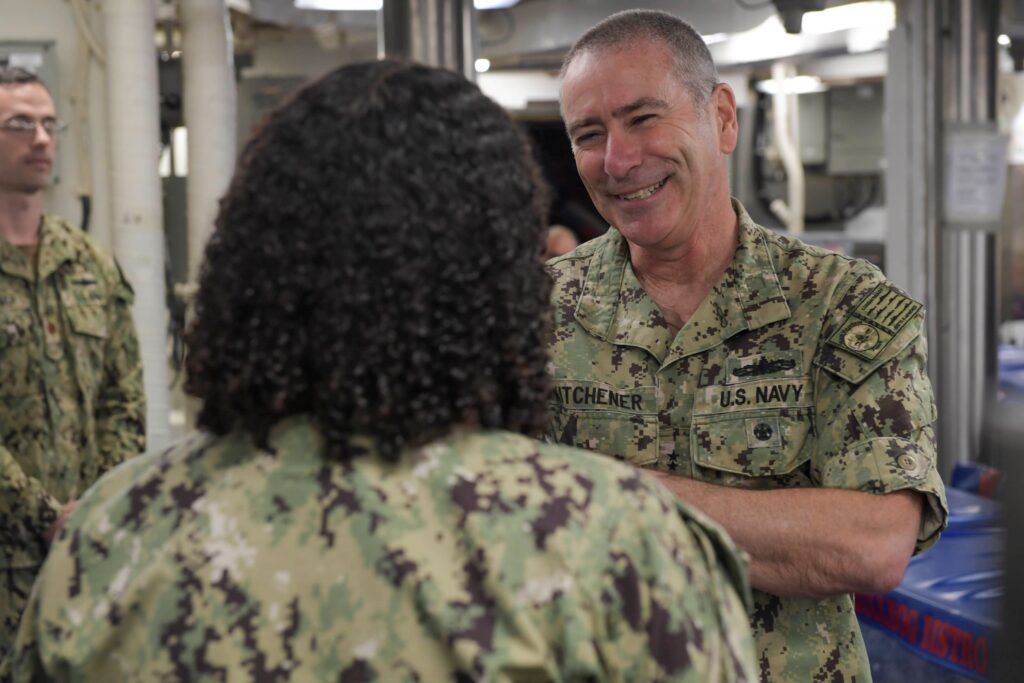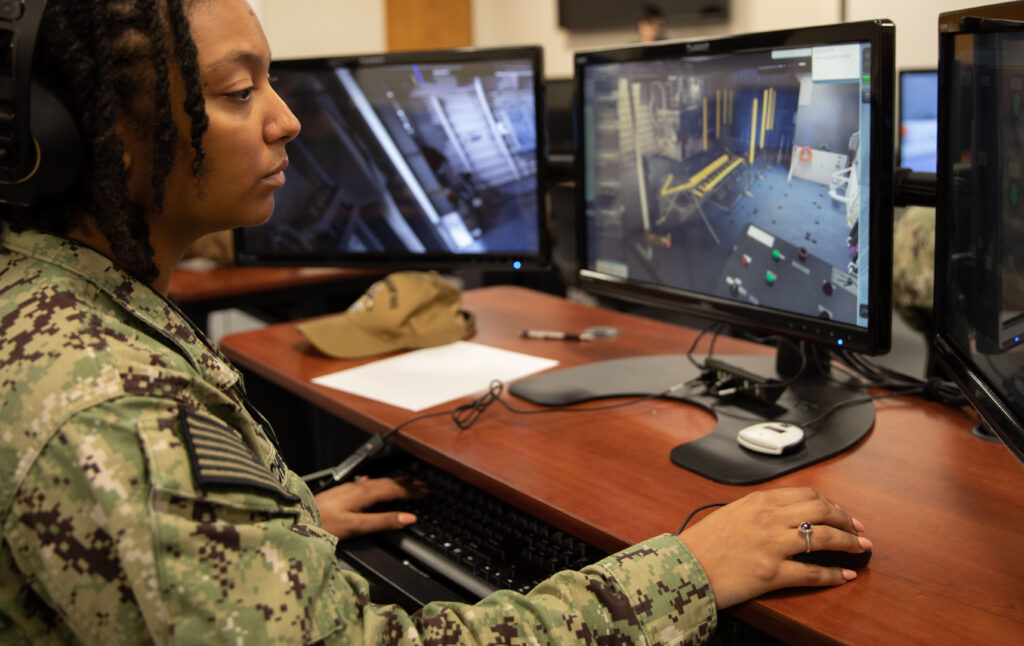
Vice Adm. Roy Kitchener assumed command of Naval Surface Forces and Naval Surface Force, U.S. Pacific Fleet in August 2020, and as a type commander he has guided the forces as he continues to man, train and equip the forces for duty in the fleet and service to the U.S. combatant commands. A native of Trumbull, Connecticut, and a 1984 graduate of Unity College with a Bachelor of Arts in political science, he attended the Navy Officer Candidate School in Newport, Rhode Island, and received his commission in 1985. He also attended the Naval Post Graduate School where he specialized in Western Hemisphere studies and earned a Master of Arts in national security affairs.
As a surface warfare officer, he deployed around the world and commanded destroyers, cruisers and an expeditionary strike group. At sea he served as a division officer aboard USS Dewey (DDG 45); operations and training officer for Special Boat Unit 26, Republic of Panama; combat systems and weapons officer aboard USS San Jacinto (CG 56); executive officer aboard USS Cowpens (CG 63); and operations officer and chief of staff for Commander, Carrier Strike Group 11. He commanded USS John Paul Jones (DDG 53) and USS Higgins (DDG 76) during the Navy’s Sea Swap Initiative, and also commanded USS Princeton (CG59) and Expeditionary Strike Group 2.
Ashore, Kitchener served as the Surface Warfare Directorate’s Naval Surface Fire Support program officer on the staff of the Chief of Naval Operations; combat systems instructor at Surface Warfare Officers School; ballistic missile defense operations chief at the Cheyenne Mountain directorate at Commander, U.S. Northern Command; and vice commander of Naval Mine and Anti-Submarine Warfare Command. He served as the chief of staff at numerous commands, to include commander, U.S. 3rd Fleet; commander, Naval Surface Forces; commander, Naval Striking and Support Forces North Atlantic Treaty Organization (NATO); and U.S. deputy military representative to the NATO Military Committee. Most recently, he was commander, Naval Surface Force, U.S. Atlantic Fleet.
Kitchener responded to questions about the surface Navy fleet from Senior Editor Richard R. Burgess.
The surface Navy is better armed today than it was decades ago, when it was primarily an anti-air and antisubmarine escort force. How has that improvement affected the morale and professionalism of surface warriors?
KITCHENER: No doubt, we have seen tremendous improvements in our network and sensors that give our ever-improving weapons better speed, range and precision. However, I would propose it is our training investments that have had the most impact on the professionalism of the force. The surface force develops leaders, warriors, mariners and managers, and each of these roles requires training, education and mentoring. A well-trained Sailor is a confident Sailor. That is why we have dedicated more than $5 billion to the Surface Training Advanced Virtual Environment for Surface Force training. Approximately 200 STAVE projects are supporting training in all areas of individual and waterfront training, including navigation and seamanship, engineering, damage control and combat systems. Furthermore, nearly 66% of all afloat billets benefit from STAVE. This training and the human factor programs that we have in place directly contribute to improving our Sailors’ professionalism and morale.
The surface Navy has had few combat actions at sea since World War II. How confident are you that today’s surface warriors are trained and conditioned to maneuver and fight as well as execute damage control should they fight a peer competitor?
KITCHENER: We are highly confident in the training and professionalism of our surface force. As previously stated, we have dedicated a significant amount of resources to ensure our force is trained and ready to meet today’s operational challenges. In addition to investing in STAVE, we are also building the physical and digital infrastructure to support this vast amount of training we are providing to our force.
Most notably, the Mayport [Florida] and Sasebo [Japan] Shiphandling Trainers opened for business in 2021, bringing the number of learning sites to 10 overall and ensuring a site in nearly every fleet concentration area. The Mariner Skills Training Centers in San Diego and Norfolk began hosting a two-phase Officer of the Deck [OOD] course, which shifted from a JOOD [Junior OOD] course to a two-phase OOD curriculum. The change freed up the Advanced Division Officer Course to expand its focus on maritime warfare. ADOC is now providing junior officers with three weeks of maritime warfare training instead of one, allowing us to lay the warfighting foundation earlier in an officer’s career.
Regarding specific warfighting training, we are installing virtual operator trainers, or VOTs, in all homeports to provide Sailors with training for the AV-15 sonar system and Aegis Baselines 9 and above. In Yokosuka, Pearl Harbor and San Diego, the sonar trainers are up and running and the Aegis VOTs in Yokosuka and Pascagoula are soon to follow.
Finally, we have worked with the numbered fleet commanders to retool and enhance the high end, at-sea training ships receive prior to deploying to ensure they are ready to defeat current day threats. Never before has our force possessed this quality of warfighting training systems in our homeports, and they are available to commanding officers to build their teams’ skills.
Has the seamanship of the force been improving to meet your expectations in the five years since the McCain and Fitzgerald incidents?
KITCHENER: Yes. We have made significant investments to increase the amount and depth of training that junior surface warfare officers receive before they report to their ship.
We introduced and implemented a revised SWO training and assessment continuum that employs navigation, seamanship and ship handling assessments across all career milestones.
We also implemented NSS/go/no-go assessments with four no-go criteria established for a SWO career path, which means that no one gets a pass simply due to experience. We assessed all officers at every level, from brand new ensign to major commander. Those who do not pass their proficiency tests do not assume command of ships at sea. Our standard: To be a professional mariner is more rigorous now than ever.
For our younger officers, the two-phased OOD course provides advanced practical instruction in navigation, seamanship, and ship handling in high-end simulators, emphasizing rules of the road, high-density shipping, in-extremis maneuvering and watch team management.
How are simulators making better surface warriors?
KITCHENER: With the number and complexity of systems and platforms planned to join the fleet in the next decade, the requirement for clear and innovative operational concepts is critical. Simulators provide our surface warriors with a controlled environment to develop and refine their mariner skills. By perfecting these skills in a teachable setting, Sailors can enter the fleet with the most advanced knowledge.

What are the chief challenges to improving force readiness?
KITCHENER: The completion of depot level maintenance on time continues to be a significant challenge. We have invested in analytics to help us improve in this area.
As I said at SNA [Surface Navy Association convention] earlier this year, we have seen improvements in two key metrics that we are using to gauge our progress: days of maintenance delay and on-time completion rates. Since 2019, we have reduced our days of maintenance delay by 41%. Our on-time completion is steadily increasing, from 34% in fiscal year 2019 to a projected 59% for all 2021 avails, including those ongoing that began in fiscal year 2021. We still have more to do, but it has been satisfying to see that the process is working.
Overcoming this challenge is even more important as we deliver modernization upgrades to the fleet, capability that is essential to maintaining our warfighting advantage. The SPY-6 radar and AN/SLQ-32(V)7 electronic warfare suite are a couple of examples of the extensive modernization programs that we will introduce to the fleet. The effective and timely execution of our maintenance and modernization packages during depot avails will be even more important to force readiness as we install this vital capability.
You have spoken about reimagining fleet introduction. What do you mean by that?
KITCHENER: Historically, NAVSEA’s [Naval Sea Systems Command’s] fleet introduction team provided oversight on the acquisition process and integrated the various program offices in the delivery of a new ship. Independently, the type commander’s fleet introduction team would be responsible for actually integrating the ship into the fleet. We feel that a good look at this process will provide us a better process. Reimagining means thinking differently about this process so that the type commander is more engaged in the acquisition process overall, and that the program offices can deliver new ships and capabilities that integrate with the fleet more effectively and efficiently. We anticipate that this review should have significant positive impact and therefore I’ve asked Rear Adm. Brendan McLane at CNSP [commander, Naval Surface Force, U.S. Pacific Fleet] to take on this task.
We are introducing at least 10 new or modernized platforms to the force in the next decade, and believe that effective fleet introduction is critical to maintaining a competitive advantage.
What is the role of Task Force LCS that stood up last spring?
KITCHENER: We stood up Task Force LCS to consolidate efforts and drive actions across the LCS [littoral combat ship] program. Experts across the Navy are working together to analyze, develop and rapidly implement improvements to LCS platform reliability, sustainability, lethality and operational employment. The task force, led by Rear Adm. Robert Nowakowski, continues to provide databased recommendations and solutions to improve the reliability and sustainability of the LCS program.
What will be the role of the unmanned surface vessel division standing up this summer? How has Surface Development Squadron One been pushing the envelope in unmanned systems?
KITCHENER: This summer, USV Division One will stand up and grow to 103 Sailors in 2022 to provide dedicated support to USV operations. The command will be led by an O5 SWO commander and will report to SURFDEVRON [Surface Development Squadron] One and operate out of Port Hueneme, California. USVDIV 1 will be focused exclusively on USV experimentation and fleet advocacy with our program offices. The division will be a cornerstone in building the foundational knowledge required for Sailors to operate and maintain the USV fleet and spearhead the development of the processes required for USV operations and sustainment.
With the Zumwalt class to be armed for hypersonic weapons, do you expect them to deploy before their conversion? When do you expect the first conversion to start and what is the planned IOC year for them with conventional prompt strike?
KITCHENER: The Navy’s Conventional Prompt Strike Program is developing a non-nuclear hypersonic weapons system that will enable precise and timely strike capability in contested environments. Fielding hypersonic weapons is a top technical research and engineering priority and the Navy continues to accelerate the development of hypersonic capabilities. The Navy is on track to field the CPS on Zumwalt-class destroyers in fiscal 2025.
In support of the Zumwalt class, being the first platform to deliver CPS capability, the Navy commenced engineering design planning that will allow for integration of CPS during a planned fiscal 2024 dry-docking selected restricted availability. The ship’s relatively large volume and timing of her already scheduled dry docking availability are key enablers to rapidly field CPS capability in USS Zumwalt.
Looking on the success of the DDG 51 class, what capabilities do you want to see in DDG(X)?
KITCHENER: The DDG(X) class will capitalize on the success of the DDG 51 class by improving an already exceptional craft. DDG(X) will utilize a variant of the DDG-51 FLT III combat system integrated into a new hull form with flexibility for upgrades, an efficient integrated power system and greater endurance, reducing the fleet logistics burden.
- SAIC Advances Scalable Open-Architecture Counter-UAS Systems - May 9, 2024
- Navy’s Triton UAV to Provide Targeting for LRASM - May 2, 2024
- BlueHalo to Test C-UAS System on Marine Corps JLTV - April 29, 2024



